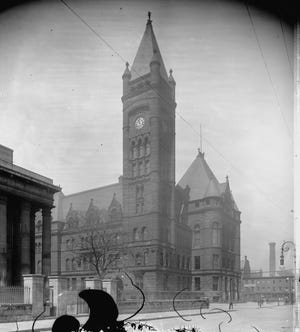

Cincinnatians will choose a new mayor this week. Voters will directly elect the city’s chief executive for the sixth time since switching to the “strong mayor” system for the 2001 election. Previously, the mayor was the top vote-getter on City Council.
Who and how Cincinnati elects its mayor has changed quite a bit over the past 220 years. The mayor’s office has been occupied by war veterans, business leaders, career politicians, trailblazers and a future celebrity talk-show host.
First mayors
The number of Cincinnati mayors can be confusing. The city website says John Cranley is the 69th mayor of Cincinnati, while Wikipedia lists 75 mayors. Even identifying Cincinnati’s first mayor is a bit complicated.
That’s because in 1802, when the act to incorporate Cincinnati as a town was approved, the ruling government consisted of a president, a recorder and seven trustees who collectively served as the Select Council of the Town of Cincinnati.
The president of the council was “a position corresponding in many parts to that of mayor,” according to historian Charles Theodore Greve in “Centennial History of Cincinnati and Representative Citizens.” Greve maintained the distinction between president and mayor, the latter position created with the town charter of 1815.

The first president – typically counted as the first mayor – was Major David Ziegler, a German-born career soldier who had served under George Washington during the Revolutionary War, suffering through the harsh winter at Valley Forge and present when Lord Cornwallis surrendered at Yorktown.
He was also part of the garrison at Fort Washington assigned to protect the Northwest Territory. He accompanied Gen. Arthur St. Clair in the disastrous defeat against the Miami and Shawnee in 1791, then retired to Cincinnati and opened a grocery store on Front Street.
Cincinnati’s first election was held April 3, 1802, with Ziegler picked as president and chief magistrate and Jacob Burnet as recorder. Council meetings were held at local taverns, and the first ordinance passed prohibited swine from running at large in certain areas of town.
Prominent citizens James Findlay and Martin Baum also served terms as president of the council in the first decade. Findlay later purchased land in the Northern Liberties, the territory north of Cincinnati’s limits (marked by Liberty Street), and had plans for a market, but died in 1835 before it was built. His family donated the land to the city, stipulating that it be used for a public market. Findlay Market was built there in 1852.
Baum is best remembered as the original owner of the mansion that is now the Taft Museum of Art. He built the house on Pike Street in 1820, but found himself in financial straits caused by the Panic of 1819 and was forced to deed the house to the bank to pay off debts. The home was later purchased by Nicholas Longworth, who added the wings.
William Corry was the only mayor of the town of Cincinnati. Under the new charter in 1815 that established the position of mayor, the namesake of Corryville was chosen by the town council. Then, Cincinnati was incorporated as a city in 1819 and Isaac G. Burnet became the first mayor of the city. Got that?
Corruption and reform
Political parties have changed over the years as well. Mayors were either Democrats or Whigs before the Republican Party emerged in the 1850s and dominated local politics for the next century.

George Barnsdale Cox, known as Boss Cox, ran the Republican political machine of corruption and graft in Cincinnati from the 1880s until his death in 1916. He didn’t hold office himself, except for a term on City Council, but he decided who did. He ran the city from his Dead Man’s Corner saloon and a table at Wielert’s Café. Cincinnati gained a national reputation as the worst-governed city in the country.
Democrat Henry Thomas Hunt finally broke Cox’s hold by winning the mayor’s office in the 1911 election, but lasted only one term. Cox’s lieutenant Rud Hynicka continued to control local politics until Murray Seasongood launched a reform campaign with his 1923 speech dubbed “The Shot Heard ’Round the Wards.”
In 1925, the father of the Charter Committee pushed for an amendment to the city charter to establish a city manager form of government with a nine-member city council that chose one of its own as mayor.
The Charterites became a local third party, and Seasongood was the first Charterite mayor in 1926. He lived to be 104 and to see his legacy of lasting change in the city government.
Political trailblazers
In 1954, Edward N. Waldvogel became the second Cincinnati mayor to die in office (the other was Leopold Markbreit in 1909). Vice Mayor Dorothy N. Dolbey stepped up as acting mayor until a new one could be chosen.
Many folks weren’t ready for the city’s first woman mayor. She held a master’s degree in child psychology, which she said was perfect training for dealing with councilmen. It took 16 votes over six months before council made up their minds to pick Republican Carl W. Rich instead of her.

“Every week they voted as to who should be mayor, and it was never me,” Dolbey told The Enquirer in 1984. “I know I worked much harder than many of the men in that council. It took a long time, almost eight years, before they began to regard me as a person.”
It took another 21 years for Bobbie Sterne to be the city’s next woman mayor in 1975.
In 1969, the Charter-Democrat Coalition formed with the agreement that if the parties won a majority of City Council, the two-year mayoral term would be split. Their takeover of council made it possible for Charterite Theodore M. Berry to become the city’s first Black mayor in 1972.
Berry was a leader and an inspiration in a time of racial and political strife. “Ted Berry is one of the greatest Cincinnatians of all time,” then-Mayor Charlie Luken said upon Berry’s death in 2000. “…He led our city to a better place in the area of civil rights.”
Springer scandal
Up-and-coming Democrat Gerald N. Springer was slated as the mayor-designate until the councilman abruptly resigned in 1974 after Enquirer columnist Frank Weikel broke the news that a “well-known Cincinnati political figure” was involved in a vice investigation. Springer admitted to paying prostitutes at a Fort Wright health club with personal checks.
The next year, a contrite Springer made a remarkable comeback and all was forgiven as voters sent him back to council. He finally got his turn as mayor in 1977.

Springer left politics for television, first anchoring WLWT news, then launching “The Jerry Springer Show” in 1991, which made him an infamous celebrity.
Democrats have held the mayor’s office since 1984. The last Republican mayor was Willis D. Gradison Jr. in 1971. The last Charterite was Arn Bortz in ’84.
In 1987, voters passed a charter amendment allowing the top vote-getter in the city council race to be the mayor. That lasted until voters approved the direct mayoral vote in 1999. Charlie Luken was the first mayor elected in both systems.
Source link







